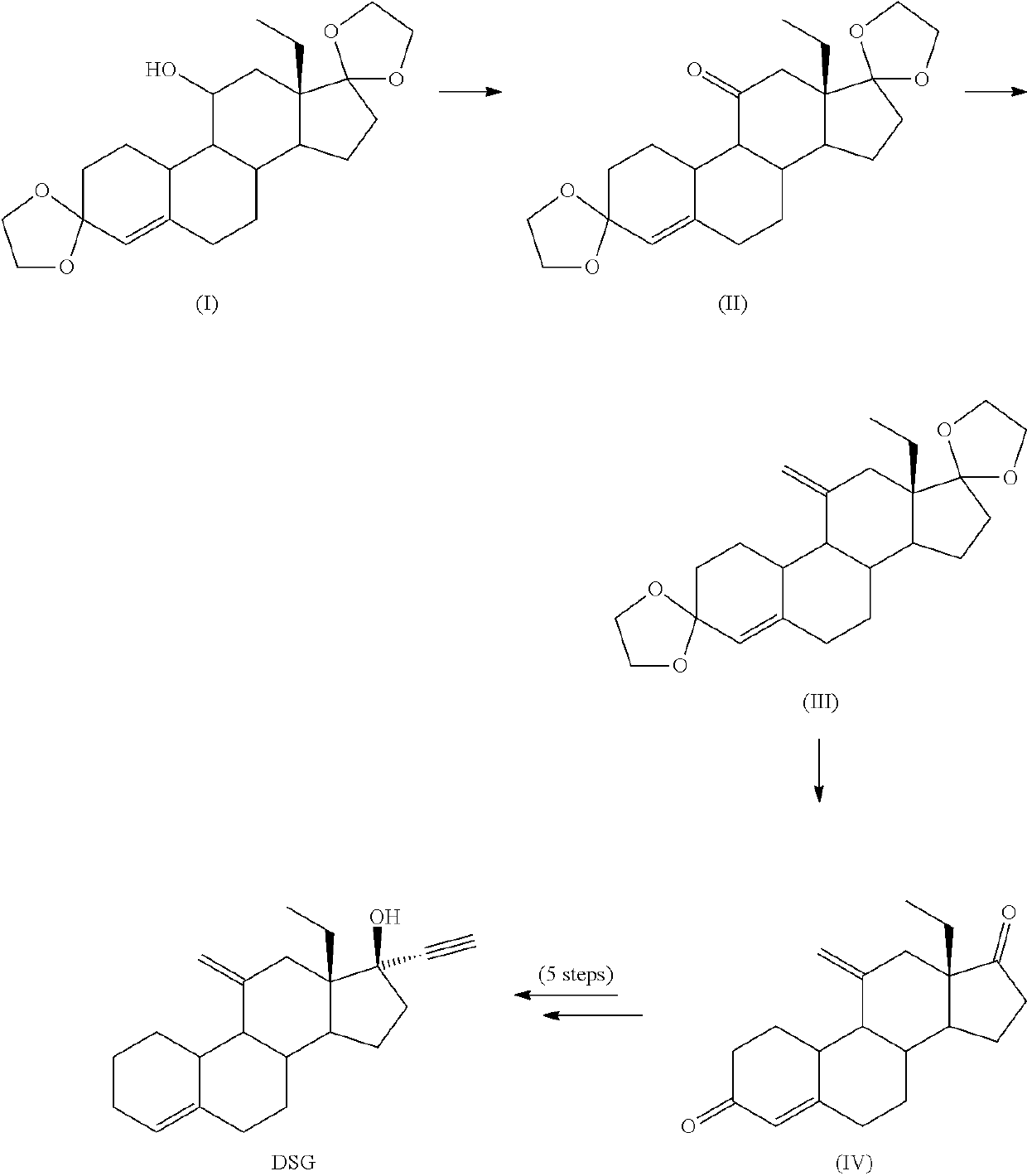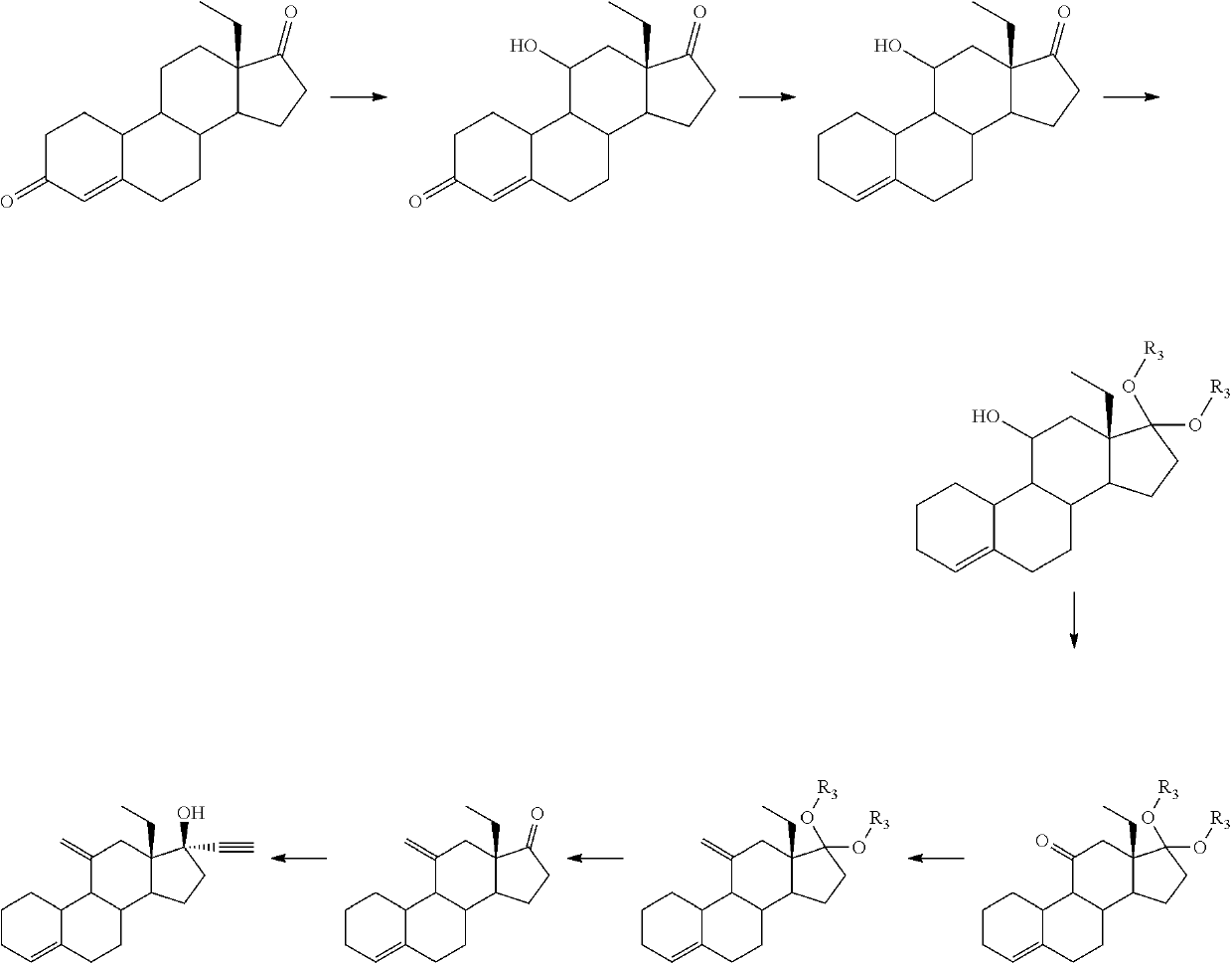Process and new intermediates for the preparation of 11-methylene steroids
a technology of steroid and process, which is applied in the field of process and new intermediates for the preparation of 11-steroid, can solve the problems of increasing the number of steps of synthesis, too long methods disclosed in the prior art for the preparation of etonogestrel and desogestrel, and not being industrially applicabl
- Summary
- Abstract
- Description
- Claims
- Application Information
AI Technical Summary
Benefits of technology
Problems solved by technology
Method used
Image
Examples
example 1
Synthesis of 18-methyl-estra-4-en-3,11,17-trione (2—Swern Oxidation)
[0272]
[0273]Oxalyl chloride was added to 540 mL of DCM at −20° C. The solution was cooled down at −45° C. and then DMSO (63 mL) diluted in 450 mL of DCM was dropwise added keeping the temperature below −35° C. After addition was complete, the reaction mixture was stirred 20 min at −40° C. Then, 45 g of compound 1 dissolved in 450 mL of DCM were then added keeping the temperature below −35° C. The reaction mixture was kept at −40° C. for 30 min, then DIPEA (235 mL) was quickly added and the cold bath removed allowing to warm up to room temperature (1.5 h). 675 mL of 3.3% solution of acetic acid were added and the aqueous phase was separated. The organic phase was washed with 315 mL of a solution of NaHCO3 7%, separated and concentrated under vacuum to a volume of 150 mL. 150 mL of IPA were added and reduced the volume to 150 mL. The operation was repeated two more times to reach a final volume of 150 mL. The resultin...
example 2
Synthesis of 18-methyl-estra-4-en-3,11,17-trione (2—Parikh-Doering Oxidation)
[0274]15 g of compound 1 were dissolved in 40 mL of DMSO and then 71 mL of TEA were added. The solution was heated at 30° C., and a solution of SO3Py (79 g) in 70 mL of DMSO were added. The reaction mixture was stirred at 30° C. for 3 h, and then poured over a solution of 117 mL of glacial acetic acid in 234 mL of water forming a precipitate. The suspension was cooled in an ice bath for 1 h, and filtered. The solid was suspended in 80 mL of IPA and heated to complete dissolution and then cooled down at 0° C. The resulting solid was filtered and dried under vacuum at 40° C. to yield 13 g of compound 2 (81%).
example 3
Synthesis of Compound 3 (Ketone Protection)
[0275]
[0276]18 g of compound 2 were dissolved in 140 mL of THF, then 30 mL of TEOF and 900 mg of pTsOH were added. The reaction mixture was stirred at 25° C. for 3 h. Then 2 mL of TEA were added, and 90 mL of solution of NaHCO3 7%. The aqueous phase was extracted with 50 mL EtOAc. The combined organic phases were concentrated until a wet solid was obtained, 90 mL of ethanol were added and concentrated to a volume of 40 mL, cooled in an ice bath and filtered. The solid was washed with 90 mL of cold ethanol and dried under vacuum at 40° C., to yield 14.7 g of compound 3 (75%).
PUM
| Property | Measurement | Unit |
|---|---|---|
| temperature | aaaaa | aaaaa |
| temperature | aaaaa | aaaaa |
| temperature | aaaaa | aaaaa |
Abstract
Description
Claims
Application Information
 Login to View More
Login to View More - R&D
- Intellectual Property
- Life Sciences
- Materials
- Tech Scout
- Unparalleled Data Quality
- Higher Quality Content
- 60% Fewer Hallucinations
Browse by: Latest US Patents, China's latest patents, Technical Efficacy Thesaurus, Application Domain, Technology Topic, Popular Technical Reports.
© 2025 PatSnap. All rights reserved.Legal|Privacy policy|Modern Slavery Act Transparency Statement|Sitemap|About US| Contact US: help@patsnap.com



